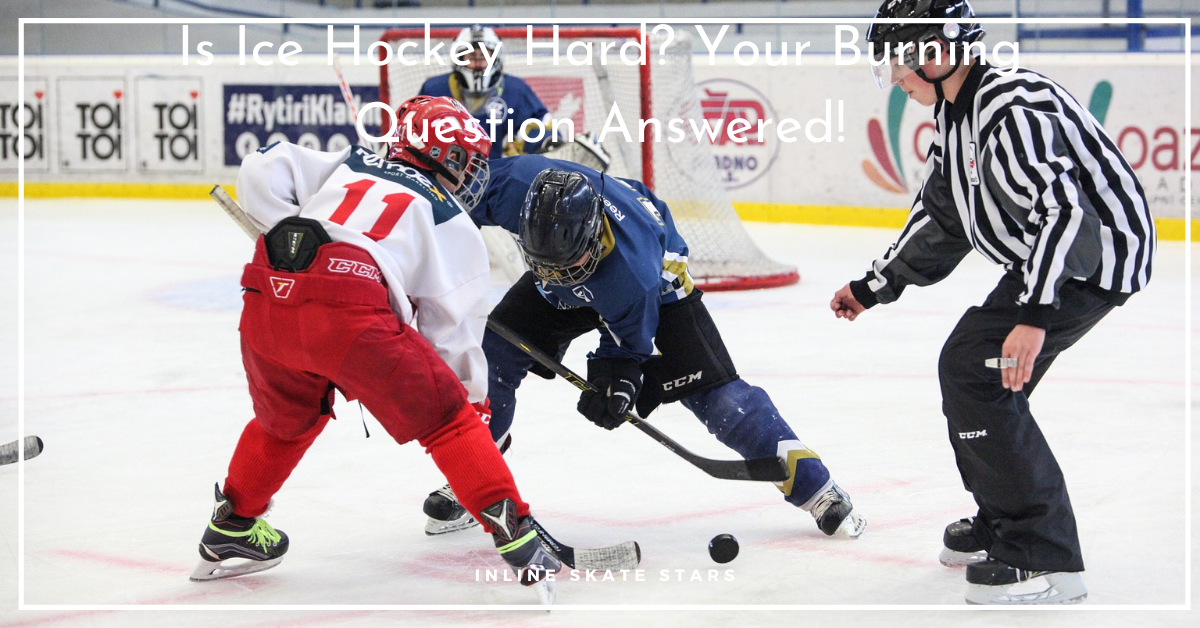Is ice hockey hard? The truth is ice hockey is a fun sport with tons of physical and health benefits. In addition, players from all works of life interact coherently to exchange ideas and to discover diversity. And the best part is some players have found full-time careers in hockey.
If you’re thinking of joining the sport, it’s worth it. But here’s the kicker! While ice hockey is fun and exciting to play, it’s also one of the most demanding sports.
Ice hockey is hard because players have to learn and master skating as a new way of movement. In addition, players play in ice rinks which are uncomfortable because of the super low temperatures. In response, players have to wear special hockey gear weighing up to 40 pounds. Players also have to learn new skills, develop body strength, and learn arduous hockey rules.
But this is only the sneak peek view. I cover all details comprehensively in the rest of this guide. So, I urge you to keep reading to the end. Let’s get to it!
1. You Must Learn to Ice Skate first as a New Way of Moving Around
The most crucial skill you have to acquire before holding a hockey stick is the art of ice skating. You’ll be lucky if you already know how to skate from figure skating or recreational skating. However, your learning curve can be steep if you’re a complete newbie.
Learning to skate should take four to eight weeks to master the basics when you practice once a week. However, if you skate at least twice a week, you should learn and master the basics in under a month.
It’s crucial to learn how to balance and coordinate your limbs to push and glide. The rinks are usually slippery, and you can’t afford to get ice skating basics wrong. Honestly, this can be harder than you ever imagined. But, the good news is it can be done. So, you only need to put in more effort.
More Reading>> Are Ice Skating Lessons Worth it?
How much are Ice Skating Lessons? The Ultimate Guide
How much are Ice Skating Shoes?
How to Avoid Falling when Ice Skating
How to Improve at Ice Skating {9 Proven Ways}
How to Practice Ice Skating without Ice
2. Ice Hockey Rinks Can Be Too Cold
Hockey surfaces and atmosphere are cold and may be uncomfortable for beginners. Ice hockey rinks atmospheric temperature are as low as 12.8°C, while the skating surface temperature is 0°C. This compels hockey players to wear special gear for protection from the cold. In addition, this will be pretty hard for beginners, and it can take longer to get used to it!
More Reading>> Are Ice Skating Rinks Cold?
3. You need to get used to Heavy Ice Hockey Gear
Ice hockey rinks are cold, and the only way to protect oneself is by wearing heavy ice hockey gear. In addition, this special gear also protects the body when playing hockey. Typical ice hockey gear weighs up to 50 pounds, which may be too heavy for some people.
An ice hockey gear comprises of the following equipment;
- Skates
- Shin pads
- Hockey sticks
- Helmet
- Hockey pants and girdle
- Shoulder pads
- Elbow pads
- Jock
- Gloves
All this equipment adds to the overall weight, making ice hockey challenging for beginners. That being said, ice hockey gear weighs approximately 25 pounds, while goalies’ equipment weighs between 40 and 50 pounds. Though it takes a while to get used to the gear, you should be fine after wearing them for some time.
More Reading>> How Much Does NHL Goalie Equipment Weigh?
4. You need to Learn and Master Ice Hockey Skills
Ice hockey skating uses skills that may be had to learn and master quickly. You need to know to skate fast since your success in the sport depends on it. Research shows that the average ice hockey players move 50km/h to either defend or score. Slow players can never make it in the sport.
Other skills you have to learn include;
- Stick handling and puck dribbling and shooting.
- Position playing.
- Analytical skills.
- Stopping skills.
- Quick turns.
- Back skating.
More Reding>> How to Stop when Ice Skating for Beginners
5. You Need to Familiarize and Master Arduous Hockey Rules
Ice hockey has plenty of rules you need to acquaint yourself with to play harmoniously with others. As a rule of thumb, you first want to go through these NHL rules to familiarize yourself.
The truth is, it won’t be easy and quick to master every rule. However, with regular practice and interaction with fellow players, you should be able to pull this off.
More Reading>> What is a Crease in Hockey? Answered!
6. Body Strength, Power, and Endurance
Ice hockey is a vigorous sport, and it requires body strength, power, and endurance. First, hockey players move at an average of 50km/h. This can be hard to pull off without adequate body strength and power.
Secondly, you have to build your upper and lower body muscles because they’re responsible for the locomotion. More importantly, you should train your body to endure muscle pain and fatigue. While this may take some time, it’s always worth it in the long run.
More Reading>> What Muscles does Ice Skating Work?
7. Agility and Flexibility
Hockey skating uses quick stops and turns, back skating, sprinting, stick and puck handling. It would help if you were agile and flexible to do these hockey skills on the rinks. Therefore, many hours go into practice to get the hang of it and train the body for agility and flexibility.
8. Confidence when Playing
Hockey can be rough! The evidence is how fights arise occasionally. This would mean the sport is only for the tough and confident individuals who can endure the setbacks. In addition, players also need confidence to play in cold hockey rinks to defend the net and opponents attempt to score.
Unfortunately, some players pick injuries such as broken arms, legs, and teeth while in action. To make it worse, players can get injuries whether wearing protective gear or not. That’s how rough hockey is! This is the reason one needs enough confidence when playing ice hockey.
9. You need Top-notch Hand-eye and Body Coordination
Hand-eye and overall body coordination go a long way when playing hockey. For example, you need to coordinate your hands while dribbling, passing the puck to a teammate, or scoring. In addition, your calculations need to be on point to avoid clumsiness when handling the puck because it can cost your team.
Moreover, the entire body should be well-coordinated because you need to make quick turns and stops. Remember, hockey players, move at an average speed of 50km/h. This can be hard to achieve with a sluggish body. Therefore, an aspiring player needs to learn hand-eye and body coordination in general.
Is Ice Hockey Hard? Wrapping Up
Is ice hockey hard? Honestly, ice hockey can be pretty hard for beginners and intermediate players. Below is a quick rundown of why hockey is hard to play;
- You Must Learn to Ice Skate first as a New Way of Moving Around
- Ice Hockey Rinks Can Be Too Cold
- You need to get used to Heavy Ice Hockey Gear
- You need to Learn and Master Ice Hockey Skills
- You Need to Familiarize and Master Arduous Hockey Rules
- Body Strength, Power, and Endurance
- Agility and Flexibility
- Confidence when Playing
- You need Top-notch Hand-eye and Body Coordination
However, as soon as one gets it, the sport turns more fun and enjoyable. The best way to get to this level of success is to keep practicing to break your limits. I hope you found this guide helpful.




